 |
|
 |
Bunkertour
2006 |
|
 |
Fort
Schoenenbourg, Maginotline |
 |
Vauquois
and Forest of Argonne |
 |
Verdun
Part 2 |
|
|
|
|
Following my successful Bunkertour in 2005
I wanted to take a chance again in summer 2006 to see the
remaining battleflieds of Verdun. Escpecially the hill of Vauquois
was something, I wanted to explore further, since my last visit
there was rather short and I only spent an hour or two on its
surface. The chance to see the inside of the hill by taking part
in a guided tour through its mines and tunnels sounded really
good. So I did a bunch of planning and went my merry way when I
found some time to go there. My friedn Oli told me just a few days
prior to my departure, that I could also try to see a Fort of the
Maginotline on my way. So I planned this as a little detour and
changed my achedule accordingly.
Sounded pretty good all in all - so
I researched a bit the Maginotline to prepare my visit. The Fort
would be my first stop on the way to Verdun. Equipped with some
printed maps of the area and a few notes on how to find it, I was
on my way to eastern france. The ride went well, except that close
to the french border there was a detour due to a construction site.
I kind of lost my track there and it took me a while to find a way
to the border in the end. But I managed to get there, despite the
obvious lack of road signs, which were supposed to be all over the
place - but just weren't. I arrived a bit after lunch time, so
thism eant I would be in Verdun a bit later then planned. My visit
to Vauquois and all of Verun thus would have to wait for the
second day.
Fort Schoenenbourg
Arriving at the Fort I had lunch quickly. After eating some
bread and stuff I went to check out the Fort. The artillery fort Schoenenbourg
is one of the few remaining forts of the Maginotline that can be
toured. It is placed 18 km northeast of Haguenau, eight kilometers
south of Wissembourg and four kilometers northeast of
Soultz-sous-Foret. It was the right conner-stone of the
Maginot-Line, the "ouvrage" Schoenenbourg is a typical
artillery bunkergroup of middle strength (size class 2). Its
construction took three years, from 1930 to 33, 1935 it was fully
armed and the internal equipment was in its place. A few
modifications were done until 1940, when war heated up between
France and Germany.
Most of it is located 17 to 30 m underground.
Only the two entrances and the battle blocks are at the surface.
The two entrances, one of which is only for personnel, the other
for material, are facing to the opposite of the enemy, in the
slope of a hill. There are shafts leading down from the entrances
to a tunnel system, including stairs and elevators. The tunnels
conncet the battleblocks with the subterranean barracks, work
shops, power station and hospital as well as ammo depots and the
commando block. Ini the main tunnel is an electric train traveling
on iron tracks, that transports all material from the material
entrance to the battle blocks via a one kilometer long tunnel. The
battleblocks are facing towards the enemy, they are compromised of
two flanking infantry casemats (Block 1 and 6), a machinegun
turret that can be lowered and two artillery turrets, each using a
double 75mm turret gun. Additionally a battle block with a duoble
81mm grenade thrower was installed.
Größere Kartenansicht
Entering the Fort...
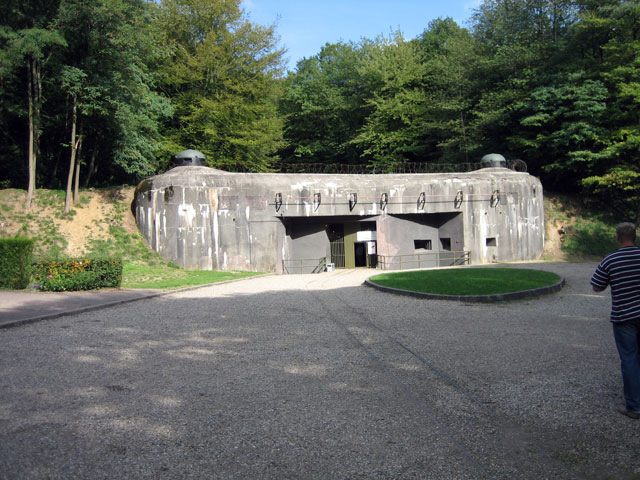
(Entrance to the fort is now through
the old material entrance.)
Arriving in the bunker, I made my
way down to the main tunnel. I had to take a rather steep but
decently sized staircase since the elevator is not working anymore.
About 15 to 20m down, I arrived at the main tunnel section.
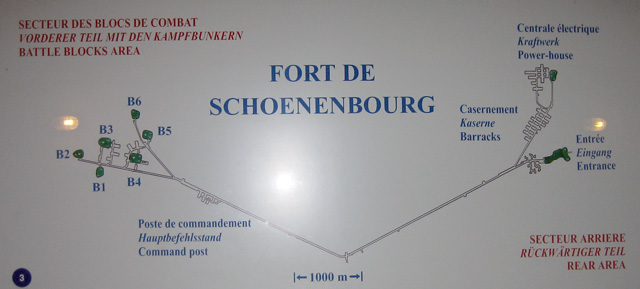
(Map of the entire bunkersystem - easy
to see, how large the system was. It takes quite a while
underground to reach the battleblocks from the underground
barracks etc.)
It didn't take long to walk down
the stairs and arrive in the tunnel - and there was my first
surprise...
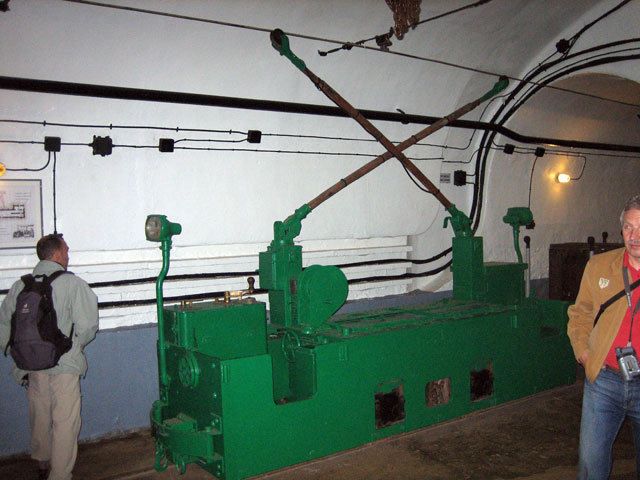
(Electrical train for transporting
soldiers and material from the barracks to the battlestations.)
I had heard before that the
Maginotline was much better equipped then the german bunkers of
its time, but this was quite a surprise. Technologically far
advanced, and even up to standard in modern times in some ways.
Unfortunately the train is not operational anymore, so you have to
walk the whole way underground. Not a very fast way to travel...
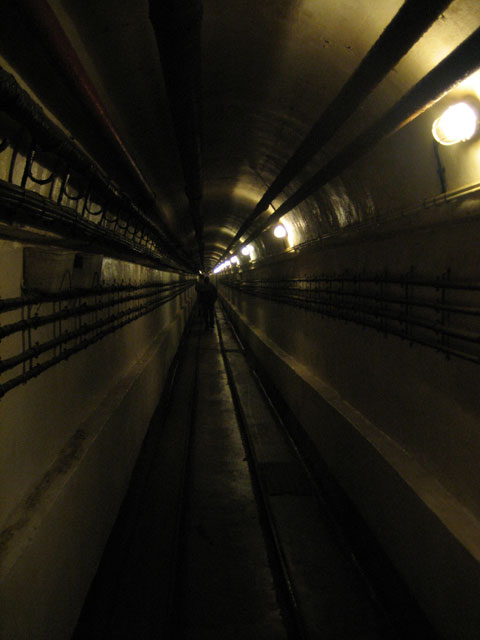
(This is how the tunnels look like.
Pictured here is the tunnel from the main tunnel to the barrcks
and work shops.)
First I decided to check out the
barracks sections and the work shops and technical installations
of the Fort. The way there was already quite a walk. In contrast
to most other bunkers, this one is in perfect condition, mostly
dry and pretty well conserved. It might have to do with the frnech
army stillusing these systems until the end of the 60ies and being
used touristically since 1982...

(A fully equipped work shop, capable
of repairing most installations in the Fort. Includes a functional
lathe among other items. Incredible!)
Astonishing what equipment was used
here. For its time the most modern (and unfortunately also
accident-prone) technology was used, so to keep things repaired
and maintained, the architects of the Fort included a full work
shop so in ccase of an emergency, the Fort could repair itself.
This was based on their experience from the first world war, where
the Forts (after being cut off for weeks from supplies) had no way
to be kept running after a while, and desperately needed to do
repairs on them. This lead to many improvisations and so the
decision was made to include work shops in future bunker systems.
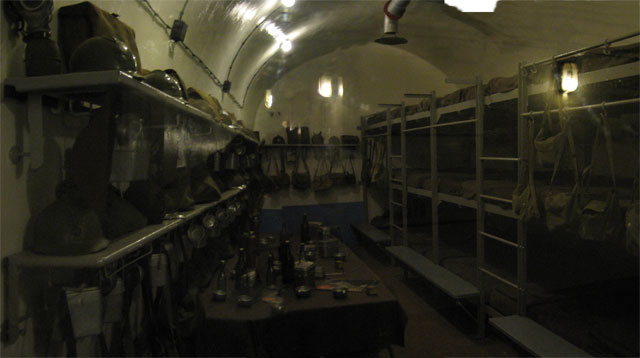
(Panorama of the barracks.)
Decidedly less luxury was given to
the soldiers manning the Fort. In comaprison to the Forts of the
first world war, these were actually pretty comfortable. Here they
had real beds and no simple folding bunks and there is even room
to hang up the gear and clothing in niches. However the beds were
not sufficient for all, sleeping was done in shifts and so dozens
of soldiers were forced to live in really cramped places.

(Hightech of the 30ies - the commando
bunker.)
This is the bridge of the bunker,
so to say. The commander fo the Fort was giving here his
instructions. Using the phones the observers in their miniature
bunkers in front of the Fort (or in the observation cloches on top
of the battle blocks) could report, what went on outside of the
Fort. Teh comander could then direct the fire outside of the Fort
using the pictures on the walls. Here were exact pcutres of the
outside represented, complete with degrees and ranges. So if an
observer reported where the enemy was, the commander could tell
the appropriate block to fire at the preplanned coordinates. The
blocks had no direct view outside and had to rely on the
instructions they were given by the commander. This protected them
on one side, however if communications were to be disrupted due to
lack of power or something else, this effectively disabled the
Fort completely.

(Generator room - to the left you can
see a single cylinder.)
The necessary power for phones,
light, ventialtion etc. was usually fed by thick cables running
fromthe bunker to the normal power lines outside. However if power
was shut down externally, the diesel engines and generators down
here would kick in and provide power to the system. To have
sufficient water, three weels were drilled within the Fort,
ensuring that the Fort would not run ot of water even if was
besieged.
When I was done checking out the
rooms of the barracks and the workshops, I went back the long way
to the main tunnel and then the even longer way to the battle
blocks. In the middle of the way there is a bend in the tunnel.
This was used to secure the Fort in case it was partially occupied.
In the bend was a small machinegun emplacement as a bunker inside
of the bunker. It could control the whole tunnel to both sides.
I went on to the battle blocks.
Unfortunately this area was very confusing and there was again a
lack of signs pointing the right way. It looked as if only one
blcok is accessibl, the others were blocked off. So I went over to
the block that was accessible, one of the artillery blocks.

(Shell chamber below the artillery
block)
the french army included a chamber
for the spent shells in the Fort under the artiellery blocks. This
makes actually a lot of sense - this way the spent shells can be
transported back through the tunnel and ne refilled, either
outside of hte fort or in the workshops. It also took away quite
some heat from the turret, if the hot shells were immediately put
in this chamber, that way also saving room in the turrets, where
price was a premium. A pretty good idea in my opinion.
A steep, narrow staircase lead up
into the turret. There was a guided tour getting explained how the
turret and the gun works, so I just joided them to hear the
explanations of the guide. The intersting part is, that the
technology how the turret operates is basically the same as in the
Forts around Verdun. What I had seen there before in rusty and
destroyed condition was here perfectly preserved and operational.
This helped explaining how they work a lot to me.
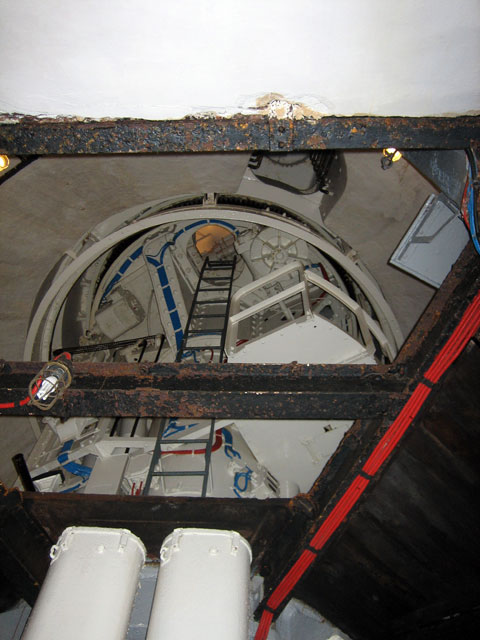
(View of the turret from the bottom.
We were not allowed to climb into the top though. )
Because the guided tour was there, the
tour guide also demonstrated how the turret gets lifted up and
down, a very cool sight to see. They couldn't fire the gun of
course (what a surprise...) but it was quite interesting
nevertheless.
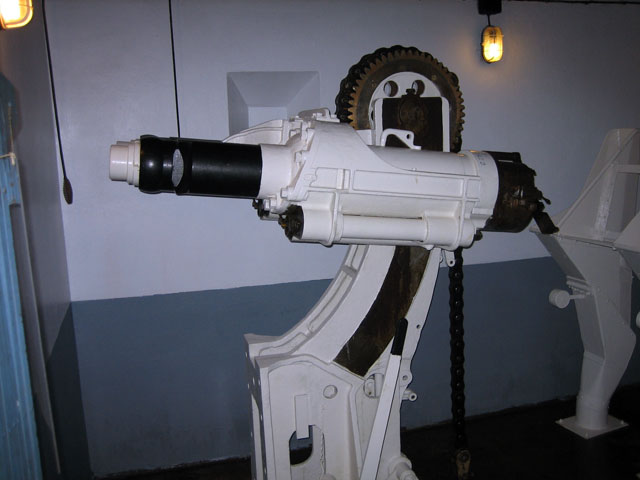
(The twin 75mm turret guns.)
To the right side of the gun you
can see the funnels, where the spent shells would be put in. The
tubes under the funnels bring the shells into the collection
chamber I saw just before that. I checked again now, if I could
see other blocks here, but it seemed to be not the case. So I
started to walk back to the entrance through the main tunnel.
The ride to Verdun would take quite
a bit of time and because of the size of the Fort, it would take a
few minutes to get to the outside anyways. Arriving there after
about 20 minutes, I took a long look on the entrance
fortifications, which I didn't check out when I arrived here
earlier. When I was done with that, I went back to the car, had a
snack there and called Tia to tell her, that i'm all good and
healthy. Lacking again of decent road signs, I couldn't find the
battleblocks outside of the Fort, so I wen t on to drive to
Verdun. It would have been interesting to see them, but it just
didn't work out this time.
En route to Verdun I crossed the
border and went on. Like last year I intended to stay at the Hotel
Formula One in Verdun, but this time arriving there, I had bad
luck: It was sold out. Damn! So I had to look for other hotels and
found one - next door. Twice the price of the Forumla One, but
also of a bit better quality. Oh well. I rented my room, went
briefly shopping in the Hypermarche and then ate bit, had a beer,
called Tia and watched a documentary onthe laptop. Charged my
cameras battery and then went to sleep early. The next day would
mean to get up very early and would have a tight schedule for me..
|
|
|
Größere Kartenansicht
|
|
|
|
Vauquois
Early next morning things started to
get busy. Washed myself quickly, packed my stuff, went downstairs
for a quick breakfast (of sufficient quality), threw my bag in the
car and checked out. I was on my way to the hill of Vauquois.
Unfortunately I did not acquire any new maps, but reused the ones
from the year before. And of course the detailed map of Verdun was
nowhere to be found - damn! Of course I got lost in Verdun and it
took me a while to figure out, where I had to go. In the end I
managed to leave Verdun in the correct direction and luckily plaaned
some extra time for the ride. Proved to be a good idea, I arrived
at 8:20AM on an early sunday morning just in time for
the visit. I pared next to the visiotrs centre at the bottom of the
hill and had a look at the small, but interesting exhibition that
they put up there. Slowly the parkign lot filled with cars and we
were enough people for a tour group underground. 10 minutes later we
went up the hill to start the tour.
Unfortunately I was the only german
to take part in the tour, so the guide did it in french. Which i
mostly understood, but not entirely. Not so bad, I pretty much knew
most details about Vauquois already from my research before the trip.
There are still always those interesting tidbits and details, that
you only learn in a local tour and those were sad to miss this time.
Anyways...
There is of course a second less then
great part of such a tour then. Whenever it was about cruelties (or
also alleged cruelties) that germans committed back then, the whole
group took a very good look at me. Hooray. What to do in such a
situation? I stuck with shrugging it off, keeping a smile .
On we went. When we arrived on top of
the hill at Vauquois, the guide told us a lot about the history of
this region, even back to roman days. Very interesting. It didn't
take too long though, until we were talking about the first world
war and how it changed this region forever. He detailed the history
of the village and of its capture and then the long battel, that was
fought where the village used to be. Also he told about the
stalemate and the trench war in the fortified positioons on both
sides. Thats when we went over to the french side to enter the
tunnel system there.
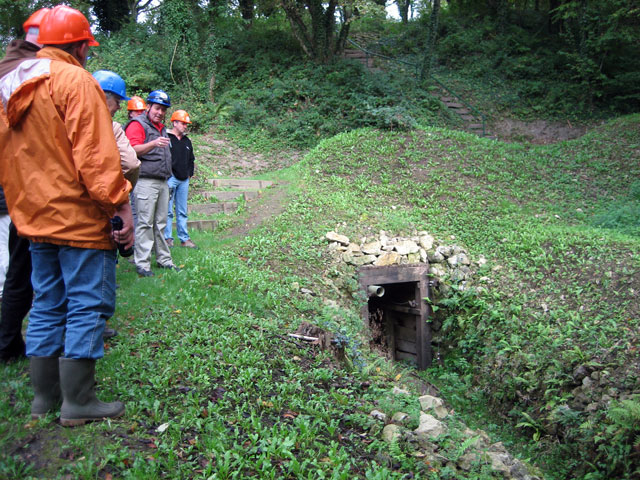
(Fren tunnel entrance. Notice, how small
and low it is built. This entrance is less then 100meteres away from
thecraters at the top of the hill.)
We
climebd into the tunnels, well equipped with flashlights and much
needed helmets. The french tunnels are very low, so we kept banging
our heads at rocks etc. Our french tour guide explained in the
meantime, how the tunnels were constructed.

(A small guard room in the french
tunnels.)
As you can see from
the bend heads, the tunnels were really small. Also the lack of any
pillars can be seen, the geology permitted stable tunnels without
much reinforcement. Nevertheless, a lot of the tunnel system is
rapidly decaying and starts to crumble. Climbing into it without a
guide is extremely dangerous. In guradrooms like we saw first, the
sldiers took take breaks. They were always listening, if the other
side was digging as well - if the digging stopped, that meant that
the other side might explode a charge to collapse tunnels etc.
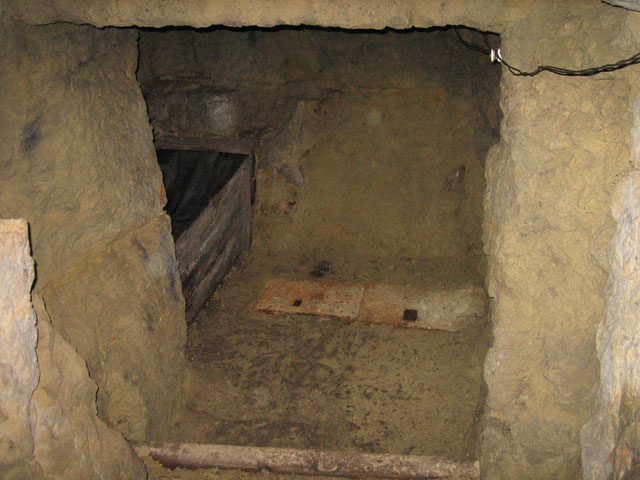
(Subterranean restrooms)
Even
such a strange sight was part of the tour: Subterranean toilets.
Next to it a water bassin, used as a sink. In the foreground you can
still see original plumbage. If this was a sewage pipe from the
toilets I don't know. Regardless: Being in here in total darkness
couldn't have been fun at all. The smell was rpbably horrible and
fresh air was a premium. This as well as the use of poison gases was
the reason why we saw so many gasmasks in the small museum at the
beginning of the tour as well as some full fledged
oxygen-respirators.

(Descending tunnel with reinforcing
pillars made from wood. The wooden hooks on the dide were used to
run cables over them and to hook up lamps.)
Our
tour went further through the tunnels on the french side.
Unfortunately we could not see the lower levels, snice they are
fully under water nowadays or so unstable, that the ceiling comes
down to often. Pity - but the upper levels are large eniugh and
interesting enough to see as it is. The tracks were used to carry
material and rocks out using lorrys and to bring food and ammunition
inside the tunnels. Easy to see: The technology here was very basic,
almost everything was done manually.
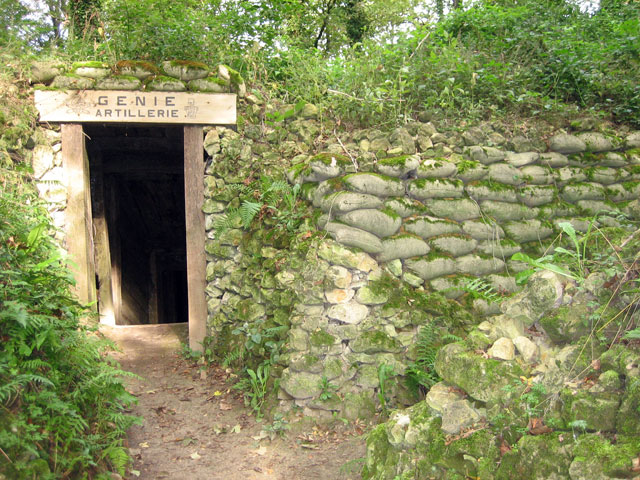
(Exit on the french side.)
Quite
a while later we left the french tunnels, having had to put our
heads neatly between our shoulders due to the low hanging ceiling.
The exit we took was even closer to the old frontline then the
entrance - it was hard to imagine, how fighting could have lasted
for four years on such a cramped, small area. We climbed back up to
the top of the hill and to the german side of the hill. A very
strange feeling, its about 100 metres, but it took the french four
years (!) to manage to get this far. In the middle between the
french and the german side is a small stone as a memorial on how far
the french came for years: Until the middle.
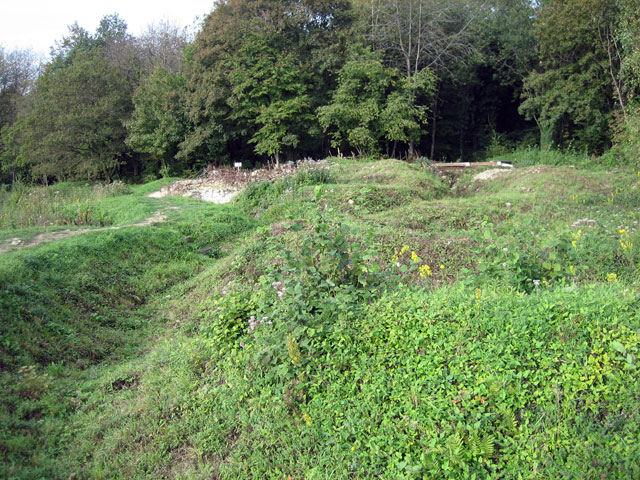
(German side with the front trench.
Directly behind is the better constructed main trench, the two lines
were extremely close together.)
Arriving
at the other side of the hilltop, our guide explained to us that the
german side was more massivley and stably constructed. The
background was that th germans were understanding the trenches as a
more permanent position while the french favored them to be only
temporary and thinnk about the war as a shorter timeperiod.It turend
out that this was easy to differentiate.
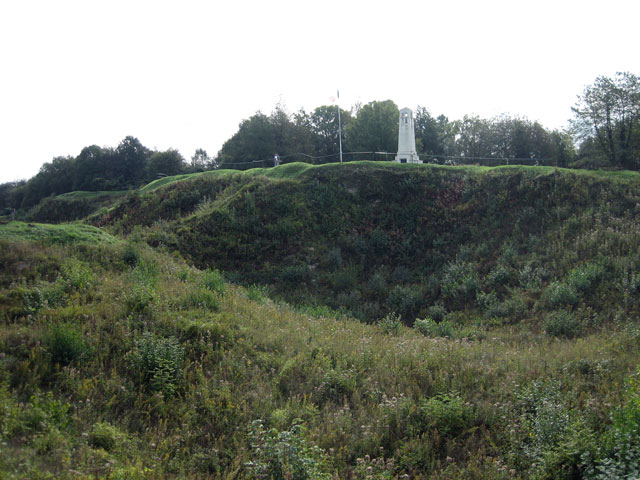
(View back to the french side of the
with the french memorial. Once upon a time - here stood an entire
village!)
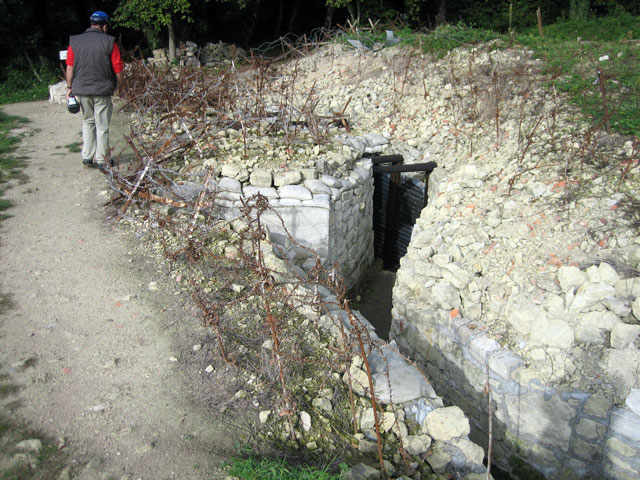
(Thick barbed wire in front of the
german main trench.)
Arriving
at the german trneches, we realized, that everything was poured in
concrete. This was not done after the war, but rather while the
fights were still going on. The reason behind doing this, was to
make the trenches more stable and ressiting to the constant shelling.
The impression of a rather permamentn fortress continued, when we
went into the tunnels here. We went into the trench and a short
while later into the tunnels on the german side.
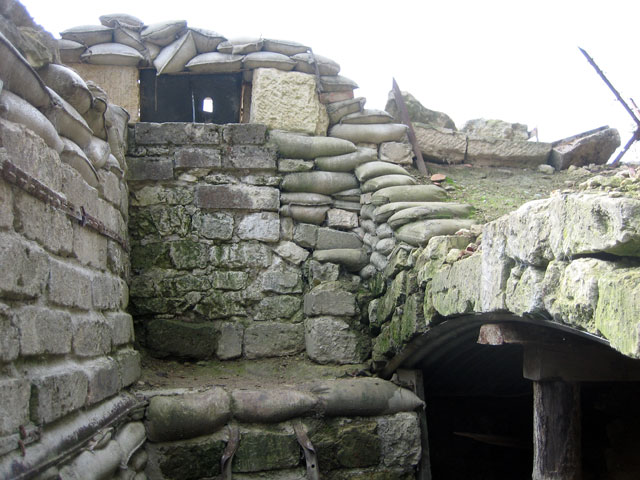
(View of the g erman trench and tunnel
entrance under the steel cuppola. Notice the fire step and the steel
armor plate for the sniper position.)
It
strcuk me, that the trench was way deeper built then the french
trenches. By using concrete, the trench was also build in two levels,
including the fire step to allow the upper level to be used for
firing and observation and the lower level for transport and
communication. Thus it was impossible to see from the french side,
where soldiers would go if they used the lower level. The trench was
not much wider then the french one, but due to the used concrete, it
did not tend to cave in like the french trenches did. We went into
the hill now, following the tunnel. I noticed the cold and wet
environment and was happy to wear my rainjacket, keeping me from
getting wet and too cold. The tunnel was much wider and higher in
comparison to the french one. Also I bumped way less my head into
the rock, since the tunnel was so much bigger.
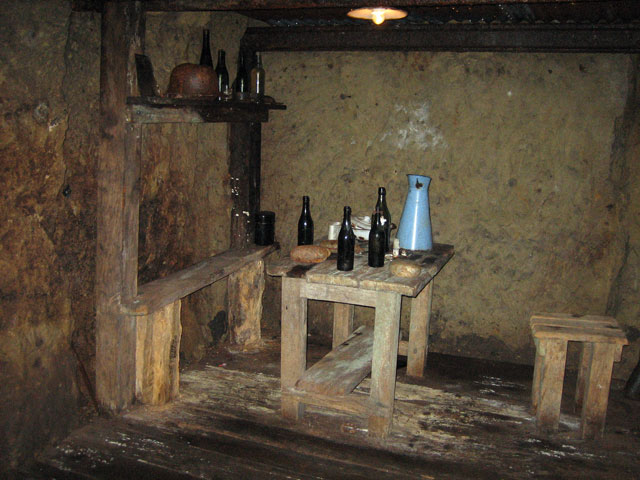
(Counterpart to the french guard room: A
german guard position. Todays serving: Coffee and beer?)
There
was much to see in those well-built rooms: The ceiling was
reinforced with stell plates, there were much more steel pilars used
to reinforce the walls, the walls were also much smoother. In the
french tunnels, there were wooden pilars, if at all. In total it was
much drier on this side. It was incredible to see, how ell some
things were preserved like bottles and some of the wooden interior
like benches and tables. Everything not metallic was in pretty good
shape, only metal was completely covered in rust.
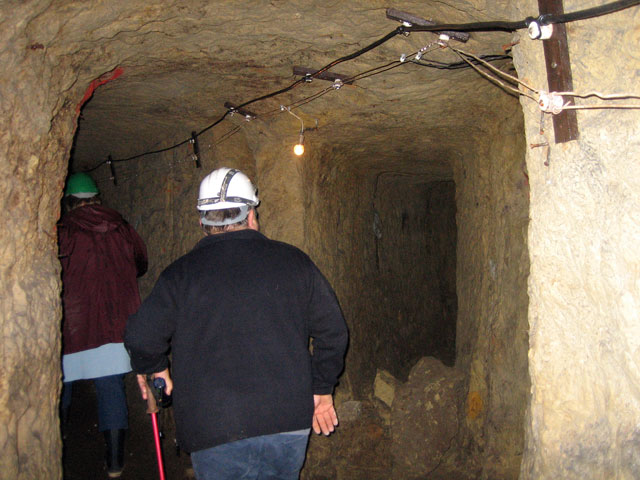
(One of the many side tunnels branching
off from the main tunnel. Notice how much room we had over our heads.
)
I found it to be really
fascinating, that the original electirc wiring was still used. The
lamps and sockets were replaced but the wirings and insulators are
still the ones from 1915/1916! In some places new wires were used
parallel to the old ones, but for the most part they used the same
stuff for 90 years here. Without a guide you really get lost in this
labyrinth though, everything looks really the same. This is why I
did not take too many pictures of the small tunnels, since they all
look a like and it gets quite repetitious.
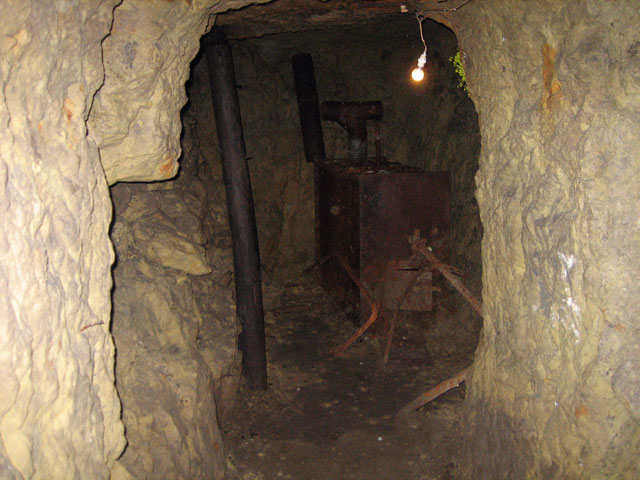
(Field kitchen in the tunnels, complete
with rusty oven. One of the few rooms that had no metal ceiling.)
Luckily
I brought a flashlogth with me. Tze pictures with flash turned out
well, but in fact light was sparse down here and orientation not
easy. It was easy to stumble and fall. On our way we saw several
dorms, a subterranean hospital, two kitchens, an officers lounge,
and lots of storage roooms. It was astonishing, how big this system
was. For the standard soldier sleeping quarters were simple niches
in the walls, horribly unconfortable and unhealthy. The conditions
must have been pretty horrific.
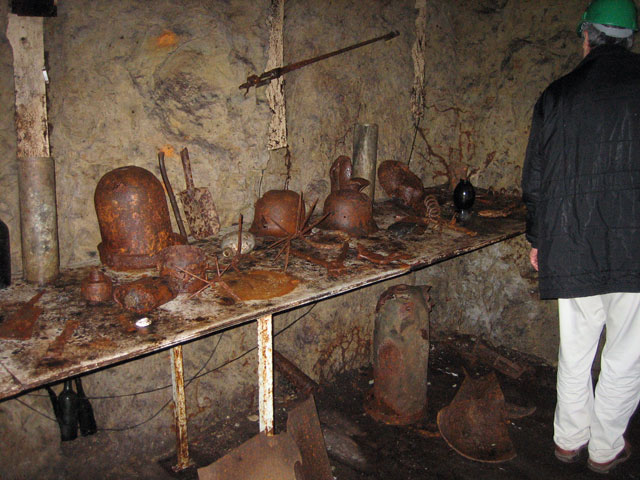
(A collection of objects, that were
found in the tunnels. Besides steelhelmets there are steel "hedgehogs",
used as simple booby traps.)
We
came to the conclusion of the tour in the underground parts of the
hill, spending more then an hour in the tunnels. In total the
tunnels run for more then 17km, of which we saw a bit more then 1km
that day. Despite that, it gave a good overview on how the system
worked and what those tunnels all look like. Also it gave a good
idea on how it must have been in the tunnels and what happened here.
It would have been nice to see, what else is there, but this is due
to the water and the dangers of the lower levels difficult to
accomplish. We went towrds the exit, close to the "Westfalenturm",
a small concrete fortified position at the edge of the german trench
system.
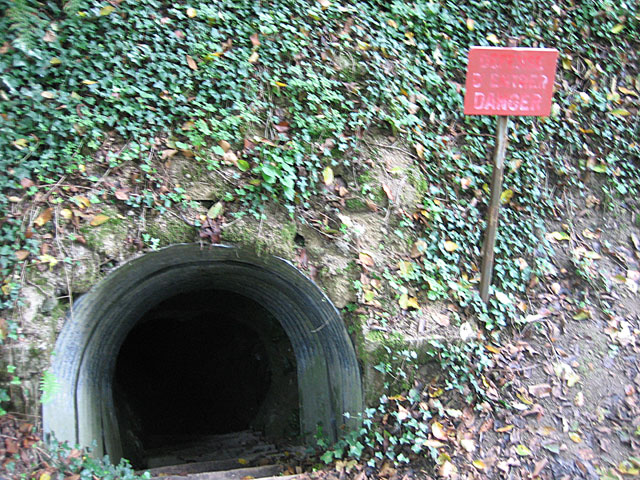
(Exit from the Tunnel to the trench,
closeby the Westfalenturm.)
After
a short trip to the less spectacularTower (basically two half round
concrete slabs at the end of a trench), we went abck to the museum
and parking lot. I returned my helmet and thanked the tourguide for
the well done tour. Could have lived without some of his comments,
but so be it. Then I had a look at the books on sale (some rare ones
among them) and almost bought some stuff. But in order to not run
out of funds, I kept myself from doing that. So I went to the next
piece of my intended trip, the argonne forest and the installations
o Verdun, which I had no chance to see before or comepletely: Froideterre
(using a better lamp and camera) and the Quatre Chemins. And
just before leaving I noticed, tha a second tour group was about to
enter the hill now - doing a tour in german. Crap. I was unhappy to
hear that this is quite regularly happening, that a second tour is
done in german. Just not always. Oh well. It was 1AM now, I had to
go on with my tour...
|
|
|
|
Argonne Forest
I continued my travel to the Argonne
Forest. Before my trip I had
researched a bit the history and what could be still seen in the
Argonne forest. The "Kaisertunnel" as well as the huge
mine craters there sounded interesting. On the way from Vauquois to
the forest is the "Kronprinz Unterstand", a small german
fortified position. Well, yh not check it out? A short detour later,
which looked small on the map but turned out to be a rather lengthy
walk on foot due to the parking lot being quite a bit further away
then it seemed, I arrived at the former Regimentsgefechtsstand.
There was not too much to see there, a few tiny concrete miniature
bunkers, each looking like the other were located in the forest.
Some impressive grenade craters close to them, of which I took
pipctures, but all in all not really wortth checking out too much.
Something to do when you saw everything else, or want to see
something small, but not the most important piece of my trip.
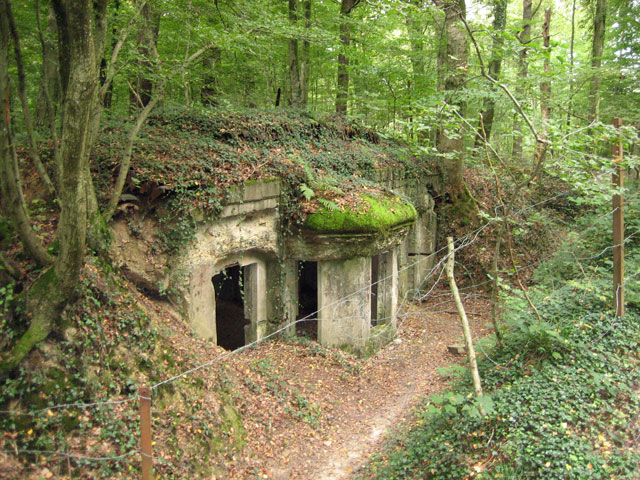
(Kronprinz-Unterstand from the backside.
Judging by the rather thin concrete walls, it is easy to see, that
this one was only splinterproof, but not a real bunker.)
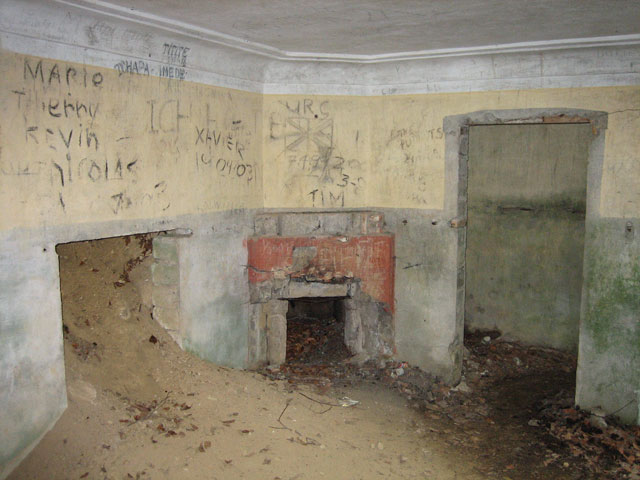
(Inside the construction. There is a
fireplace in the middle and two small rooms to the side. One was
caved in.)
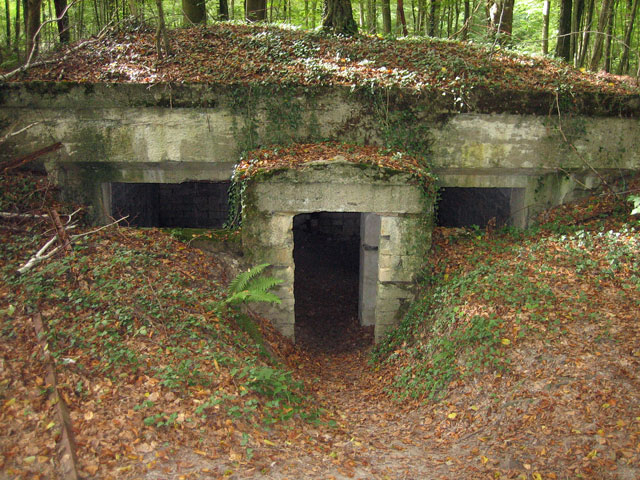
(Second, even smaller part of the
position. Again rather thin walls, setup much simpler and more basic
then the first building.)
Within a few minutes I had seen
everything there was - so I made my way back to the car. This took
actually longer then my intended visit to the site, but that
sometimes just is the case when doing trips like this. Not
everything is great or unique...
My next target was "Hill 285",
a nearby hill-top where a huge german mine was detonated in 1016 and
left one of the biggest craters of the war. This is another case of
the picture not doing justice to the size at all. What looks so tiny,
is indeed rather big and huge. A very wide and deep crater within
the forest looks like a shallow unimpressive ditch on camera. Too
bad. I had to take three pictures (!) to fit this massive hole in
the ground on film. Maybe this gives an idea on how huge this thing
really is. Similarly sized craters are only to be found at the Somme
and in Flanders, where I want to go sometime in the future.

(The big mine crater, size can be sort
of determined by the white sign in the background next to the tree.
That sign is mansized!)
Once I'd seen this seemingly
unspectacular, but in reality rather impressive picture, I followed
a path through the forest, which was set up to educate visitors
about the battle that took place here. Not in the best shape since
some signs are missing or in bad shape, it was still interesting to
see. It leads from the mine crater down the ridge thrrouogh the
forest to the so called "Kaisertunnel", a tunnel
constructed by the german army to safely reinforce and supply its
troops in the front trenches. The path was set up in a quite
interesting way and on its corners you could spot occasionally some
remains of the war.
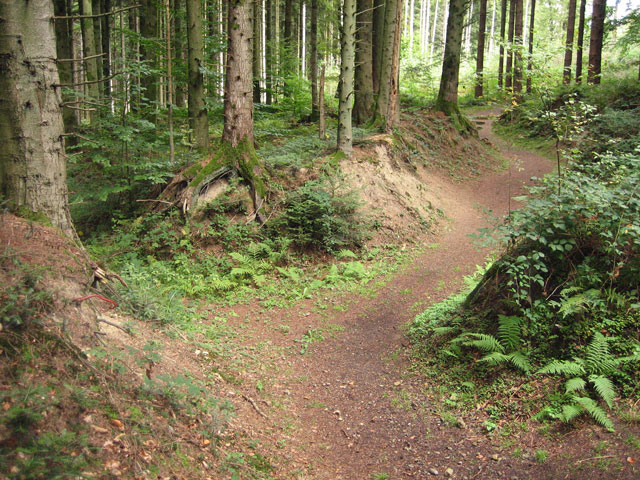
(Path through the forest, along old
trenches and craters. On the left next to the tree and its roots is
a red marked fencepole for setting up barbwire.)
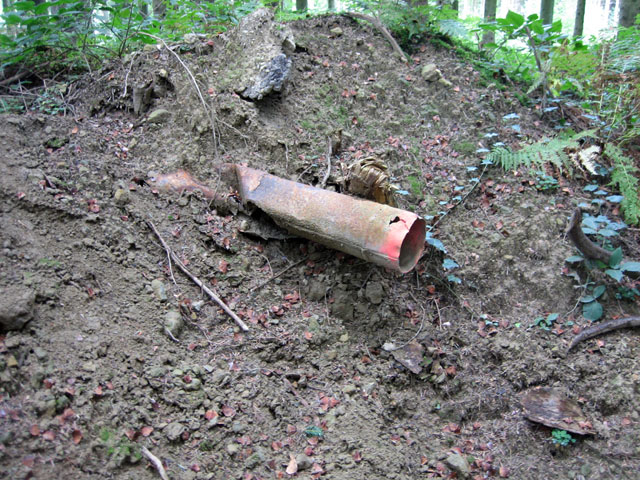
(Waterpipe or grenade shell? I didn't
touch it.)
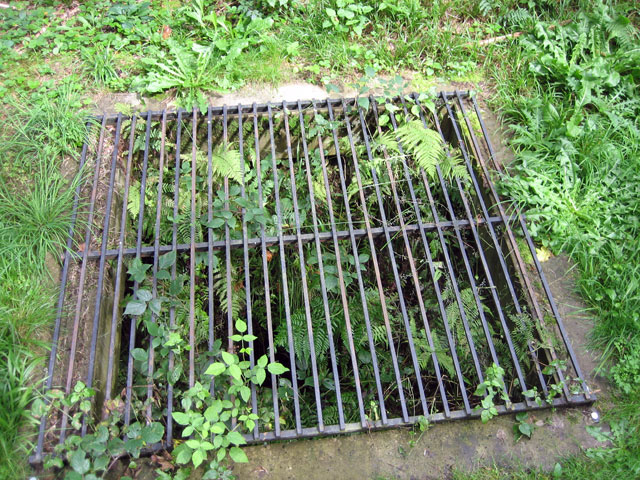
(Entrance to a mineshaft - probably
sealed for security reasons.)
A short while later I arrived at the
Kaisertunnel and learned, that I was about 30 early. Due to my
rather short visit of the Kronprinzunterstand, the path through the
wood also being of a rather short distance, in total I was an hour
ahead of my plan. What to do? I decided to take an extended lunch,
delete bad pictures from the digicam and to check out the memorial
plates next to the road. Had a short conversation with a couple from
Belgium about the area and then went back to the tunnel with them in
tow.

(The Kaisertunnel - still closed. Pity.)
At the tunnel, we took part in a
guided tour through it. Unfortunately the tour was about the worst I
had seen so far. The guide was the epitomy of disinterest. A few
germans joined the guided tour (which was exclusivley in french, so
the two Belgium folks were the only ones besides me to understand it
more or less) so I played translator to the rest of the group.
Thanks to my research beforehand and former visits to Verdun I had a
pretty good idea, what was what here and how things went. I could
also help to clear up some of the bullshit our guide told the group,
since I knew a tad bit more about things then he did. A sobering
experience.
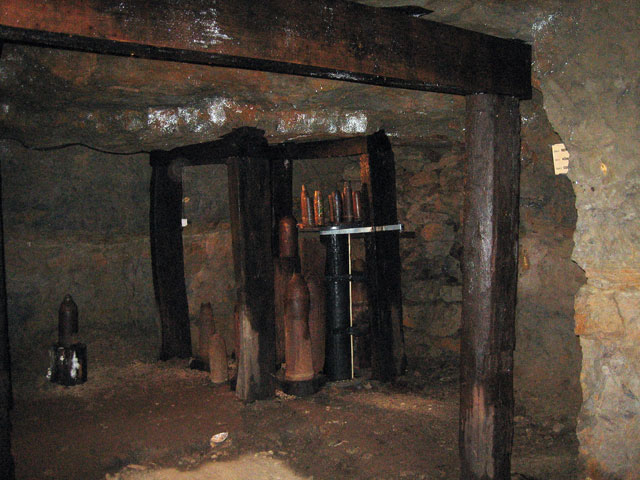
(Ammunition depot)
The tour began with one of the many
ammo depots that were in the tunnel. Close to the entrance was also
the water storage, formed by a cisterne. There were also some
sleeping rooms as well as a guard room in that area. Even a
subterranean hospital was around.

(Water storage of the tunnel, still
filled with muddy water.)
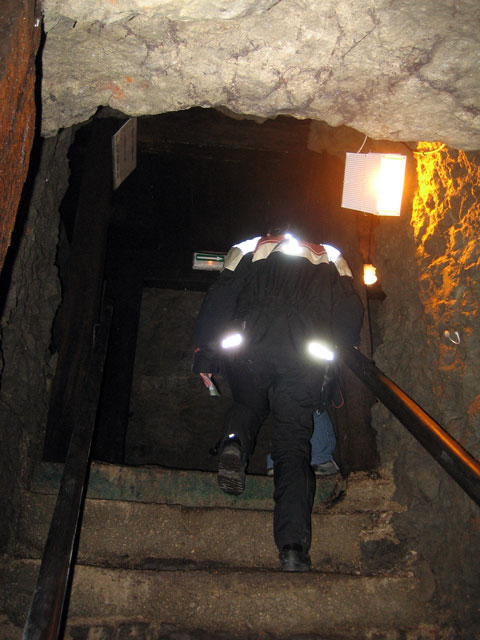
(A very stable construction, built to
last a while.)
The stairs in the tunnel were all
poured with concrete, its construction reminded me of the tunnels of
Vauquois, just larger. Of course the german side, the french tunnels
were much smaller. Being pampered by the excellent tour there, the
disappointing tour here was a stark contrast. The Kaisertunnel was
also less spectacular in comparison to Vauquois. Still interesting
to see.
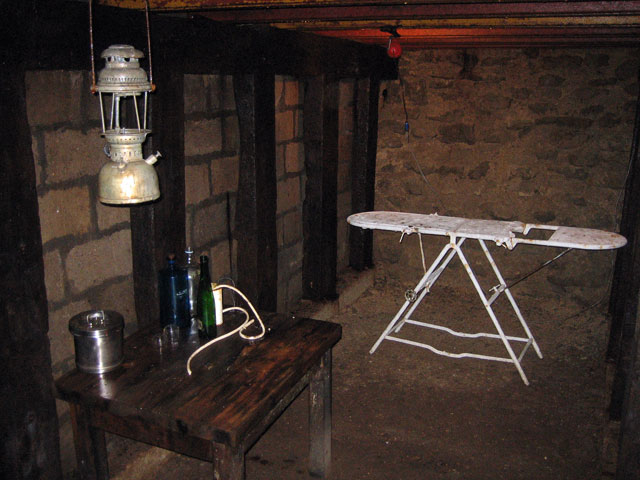
(The hospital in the tunnel system. This
is not an ironing board, that's a folding surgeons table!)
This rather basic hospital in the mud
made me really shiver. In times before anitbiotics, only using the
light of gas lapms they did amputations, wound dressing and what
have you here. Horrible thought. A rather catastrophic way to deal
with injuries - still the best they could do. A very disheartening
idea. Especially since the beds of the other patients were just two
metres away from this place.
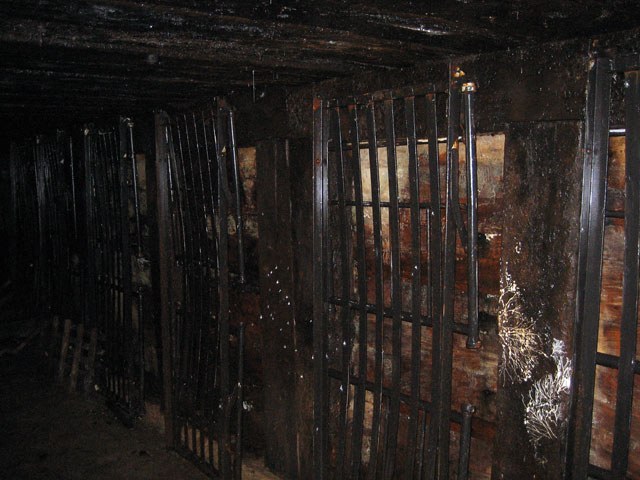
(Foling beds for the other patients.)
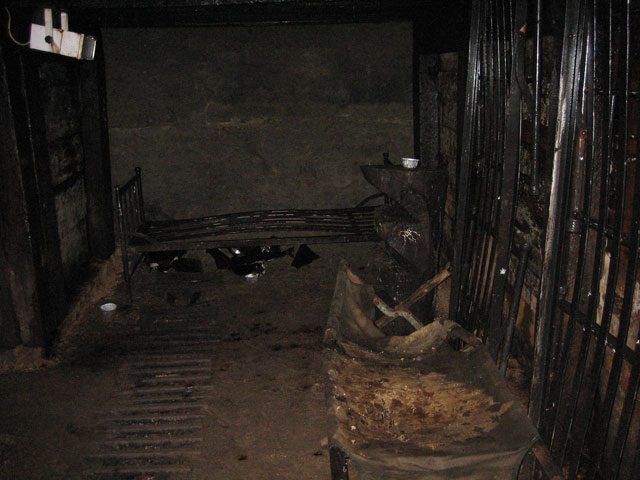
(One of the beds folded out. The not
working light in this room made taking pictures nearly impossible.)
We followed the tour further through
the tunnel, which was a bit too well built - it reminds me more of a
visitors cola mine then the original shape of the tunnel in wartime.
The way they improved the tunnel is good for disabled persons, but
it takes much of it away, how it originally was.

(Renovated main tunnel.)
Our guide was then showing us the
last few rooms in the system and then made us leave in a hurry. That
guy was completely not interested inhis job nor in our attempt to
visit this system properly.

(Guard room like in Vauquois.)
Well, this was half an hour under the
earth, which I would have found as interesting and informative, if I
wouldn't have had to follow this tour guide around. Despite the
sub-par tour, it was quite interesting to see, but only if you
haven't had a chance to see Vauquois. Gives a good impression about
warfare under ground and how those tunnels were built.
I went on with my tour then, since I
still wanted to see Froideterre, take better pictures there this
time and try to enter the part of the Fort, which I couldn't enter
last time I was in Verdun due to my flashlight failing. The way
there took me while, its not a really short ride by car. Arriving in Froideterre,
I took a short break, had a little snack and had a caffeinated, cold
beverage. The night was not as long as I had hoped, so this was
quite welcome... In my last travel report I talked about Froideterre
already, so I leave most pictures with just a short explanation.
|
|
Verdun, part 2
Not much more then an hour after
leaving the Kaisertunnel I arrived at Froideterre. My visit would be
shorter then last year, since I saw most of the system already and
was here, to take better pictures only and see the part I missed
last time. So I first went into the main tract of the fortress,
where my flashlight failed last year and folled the tunnel to its
end. I realized then that I was missing less then a 100 metres of
the whole construction - not a lot. But I could limb up a ladder to
ging ich zunächst in den Haupttrakt, wo damals meine Lampe
ausgefallen war, folgte den Gang bis ans Ende und stellte fest: Mir
fehlten damals nur ca. 100 Meter, um alles zu sehen, was es noch zu
sehen gab. Immerhin konnte ich eine Leiter recht hoch klettern, die
mich bis in eine der Maschinengewehrkuppeln führte.

(Frontal view of Fort Froideterre, practically
unchanged from last year.)
Again I was lucky, the doors were
open so I could enter the fort. I first tried to take the pictures,
That I couldn't properly do last time I was around.
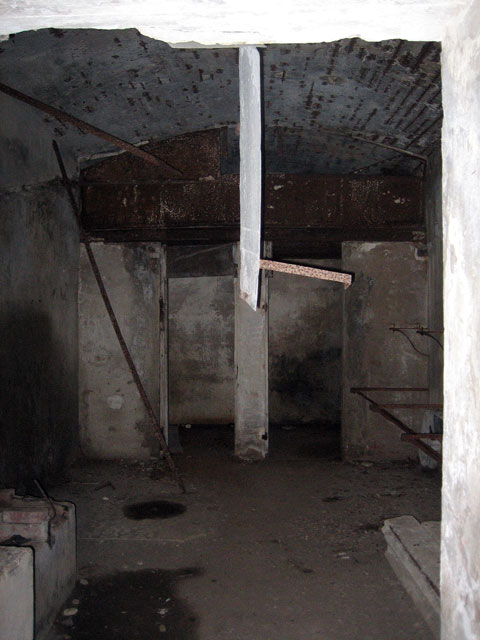
(My personal enemy in the fort - the low
hanging sheet of steel which I hit head on last time.)
With the new camera, taking pictures
was much easier and better, despite it being pitchblack in the
fortress. The flash works surprisingly well in medium-sized rooms.
This time its much easier to see what I hit with my head the first
time I was in the fortress: A piece of the ceiling cover came dwon.
To the right there are still the metal bed frame holders, left is a
concrete table or something similar.

(Caved in ceiling in the sleeping room.)
Much better then last years picture,
its easy to see on this picture that in the background there is a
small niche. There seemd to have been a door mounted to those hinges
- maybe the escape tunnel? The shadows of the hinges can be seen,
maybe I should check this out next time I'm around.
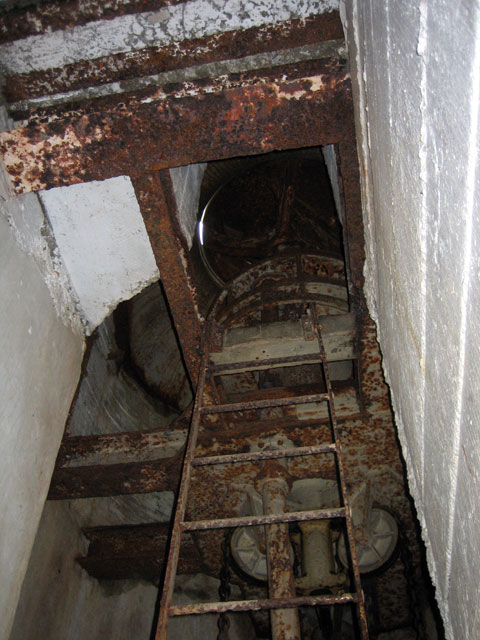
(And here I got stuck last time - the
climb to the machinegun cupola.)
This time I was able to see the rest
of the fortress, which admitteldy was not much more. Less then 100
metres of it I had not seen, and most of it was just two tunnels,
that lead to an observation cloche as well as a machine gun turret.
I climed the ladder to the MG turret, but the construction was very
rusty and looked to fragile to hold my weight.
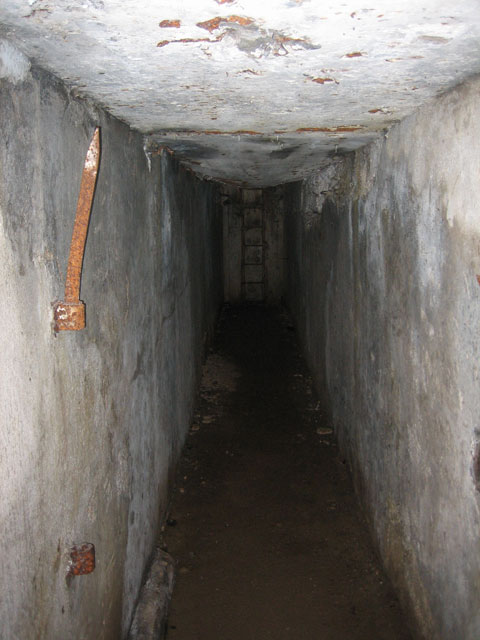
(Here my lamp went out last time - at
the end is the ladder to the observation turret.)
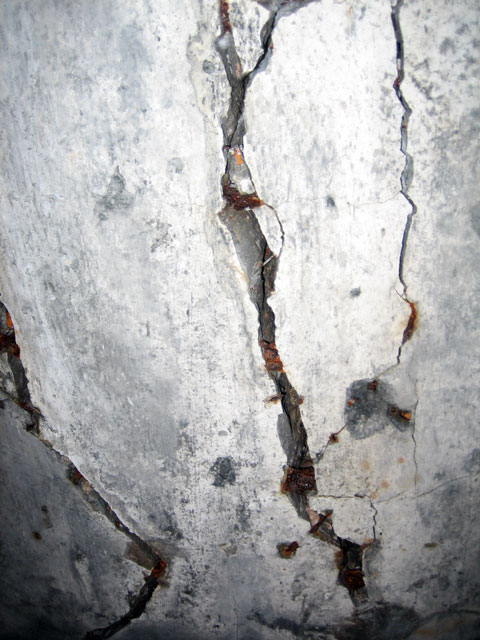
(Such cracks are all over the place, the
fortress is seriously deteriorating. In some places the walls and
ceiling are prone to come down. )
After seeing the unknwon parts of the
fort and witnessed its deteriorating state, I went to see the other
part of the fort, which is nowadays not directly connected anymore:
The battle blocks. I got a little surprise there - I could actually
see how the fortress falls apart now rapidly.
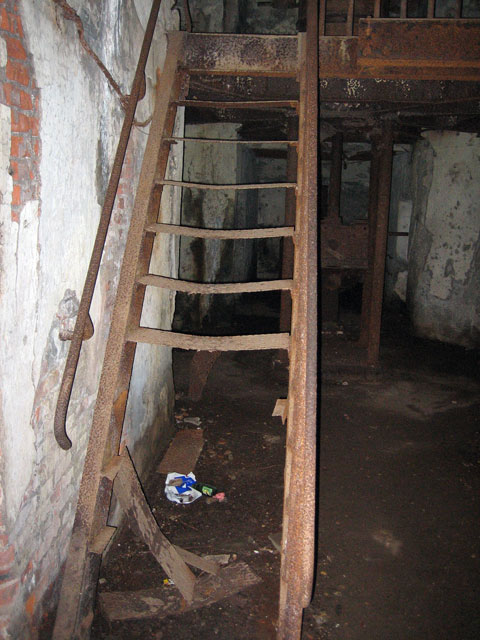
(In comparison to last year, two more
steps in this ladder are missing now. Climbing it is completely out
of question without additional help or tools!)
My advantage to last year was this
time, that thanks to my visit in Schoenenbourg I had a good idea
what the construction under the ladder was for. It was for lowering
the turret on top of the bunker. Taking a closer look at it, I
discovered that it was not only the same construction idea, in fact
it was the very same construction as inSchonenbourg, just without
machinery. But even in Schoenenbourg it was possible to raise and
lower the turret manually with this construction.

(Mechanic for the turret.)
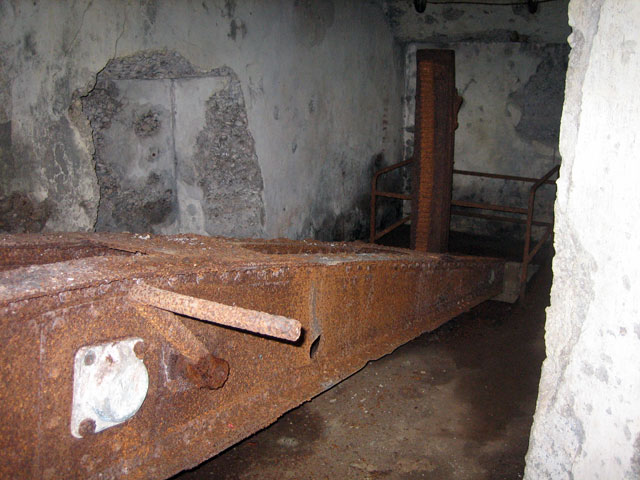
(Hand crank for raising and lowering the
turret, in the background the toothed axis on which the
counterweight is connected. )

(View of the exterior.)
The
outside of the fort was used for some art exhibition, which I took a
short look at. Not entriely my taste, I decided to skip the rest of
my visit and went on to see the tiny infantry bunker PC120,
my optional goal for the day, located between Froideterre and Quatre Chemins.
A short walk later into the forest, I sam this small, heavily
demolished bunker. 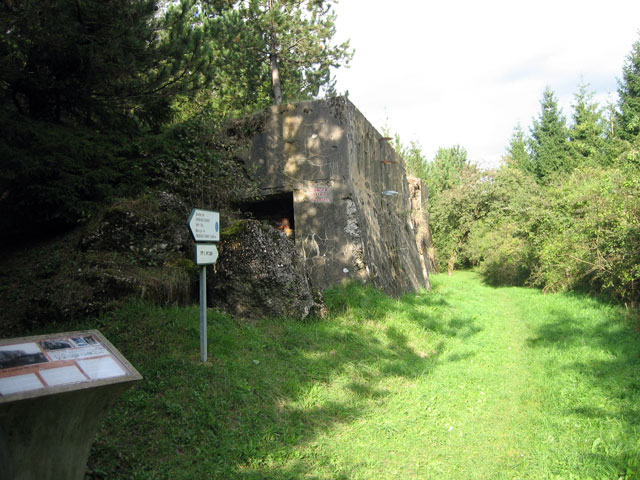
(Bunker from the outside.)
So
this is how those infantry bunkers looked undestroyed, that I
checked out last year already at Fort Douaumont. The sign at the way
explained, that this was an important fallback position for the
french army and was used heavily by troops, carriers and couriers.
It is surprisingly intact inside, despite the shelling it
experienced. 
(View of the entrance.)
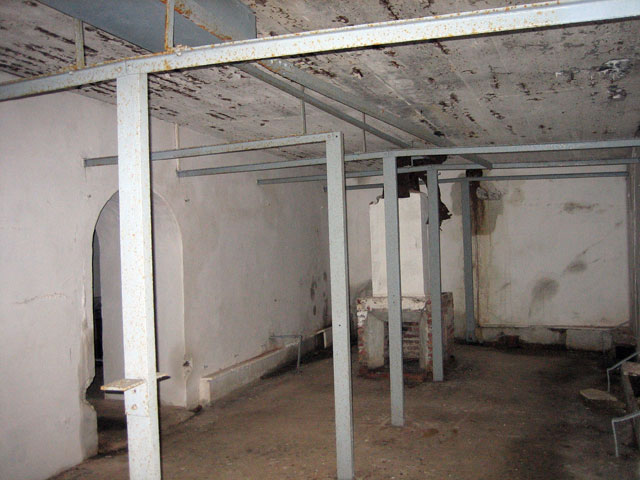
(Inside of the bunker, there is a
fireplace in the middle of it.)
After
that I went to the "Quatre Chemins", a rather large
infantry bunker, which was used as a subterranean barrack. My last
stop in Verdun for this trip, unfortunately there is little to see.
Mainly its the four ventilation shaftas, that gave the name for this
bunker. Also the armored doors, and a large tunnel in the earth,
that was used as barracks, hospital and guard room. I had huge
problems taking a good picture of it, since my flash was stronger
then the old one, but not strong enough to illuminate the whole
system and so everything is just black after a few metres. Oh - and
there was no light in that thing at all. 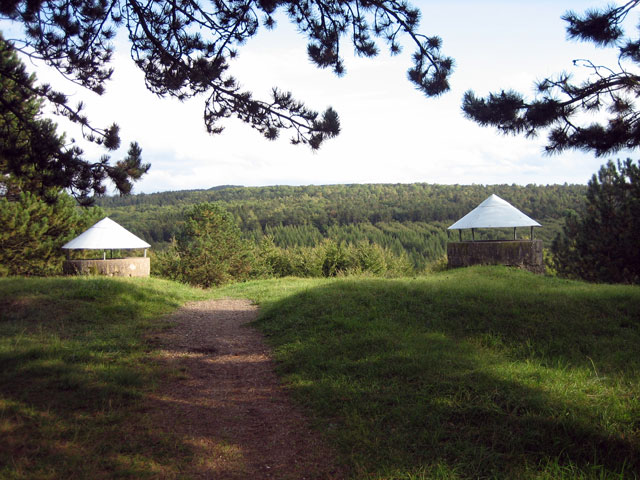
(Two of the typical venting shafts.)
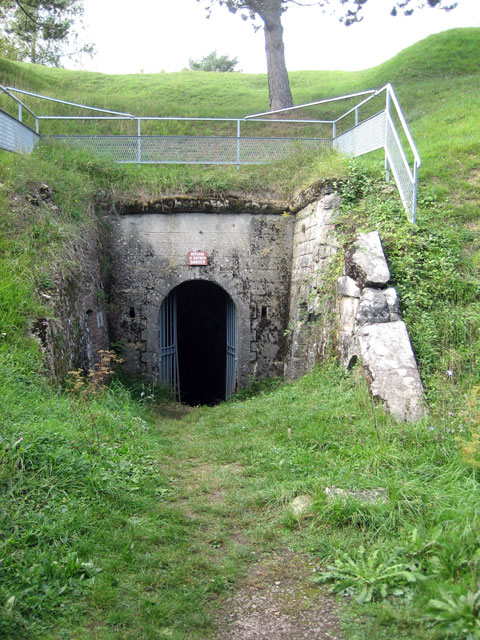
(Entrance to the barracks.)

(View of the inside, nothing to see
except for trash and darkness.)
Due to my rather long ride howm; I
left now and went back, starting at 4PM. A few hours later after a
rather uneventful ride, I managed to be back home.
|
|
|
|
|
|
|
Last update 10/31/2009 |
|
|